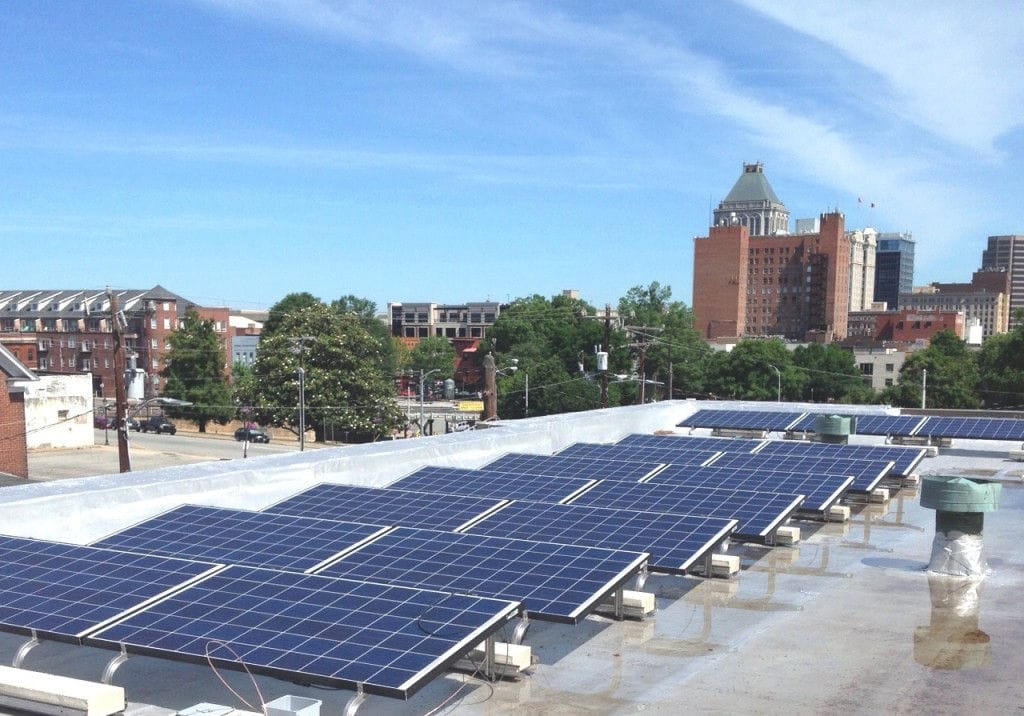Report: Many Factors Contribute to NC’s Solar Renaissance
North Carolina’s stratospheric ascent to becoming the nation’s fourth-largest developer of solar energy is the result of numerous forces aligning under the sun, according to a report issued Monday by the Rocky Mountain Institute.
The institute’s report summarizes a slew of recent reports that track different aspects of North Carolina’s solar renaissance, underscoring this state’s transformation from solar pipsqueak to solar powerhouse.
As of December, North Carolina had 953 megawatts of installed solar capacity, roughly equivalent to the power capacity of Duke Energy Progress’s Harris nuclear plant in southwestern Wake County (except that a nuclear plant runs round-the-clock). That makes North Carolina fourth in the nation overall and second in developing large-scale solar farms.
At the state’s current trajectory, Navigant Research forecasts North Carolina will have about 3,000 megawatts of solar power installed by 2023.
“In just eight short years, North Carolina has gone from having almost no solar capacity to becoming a national leader,” the RMI report states. “The state shines in particular in the category of large, utility-scale projects, where it ranks second in the nation, behind only California.”
The nonprofit Rocky Mountain Institute was co-founded in 1982 by physicist and author Amory Lovins, an early advocate of renewables and energy efficiency who in 2009 was named by Time magazine one of the World's 100 most influential people.
RMI attributes the success of solar power here to such factors as visionary private sector companies, including Duke Energy, Strata Solar, FLS Energy,SunEnergy1, Nerenco and O2 Energies.
But the group’s report doesn’t get into controversies that roil the state and could put an end to the solar expansion at any time. One such battle is the ongoing Republican effort to end or curtail the state’s Renewable Energy Portfolio Standard, the 2007 law that requires electric utilities to use renewable power. Just last week, a legislative attempt by Rep. Mike Hager to kill the mandate narrowly failed in a N.C. House committee, preserving the mandate for the time being.
Even as Duke Energy expands its solar program, the Charlotte-based utility company has made noises about reducing the amount it pays for solar power purchased from households and businesses. And Duke also opposes a legislative proposal to allow households and businesses to buy electricity directly from third-party solar power developers.
RMI’s report cites a 20-page study by the Pew Charitable Trusts, which notes that North Carolina was the first state in the Southeast to implement a Renewable Energy Portfolio Standard, requiring that 12.5 percent of the state’s power sales come from renewables and energy efficiency by 2021.
Another solar contributor is the state’s 35 percent renewable energy tax credit, which developers can pair with the federal 30 percent renewable energy tax credit, to cut the cost of a solar farm by more than half.
However, the state tax credit is set to expire Dec. 31, and environmental advocates are mounting a full court press in the legislature to extend the tax credit.
Federal law requires electric utilities to buy power from renewable developers, but North Carolina goes beyond the minimum requirement. Unlike most states, North Carolina requires electric utilities to sign 15-year fixed-priced contracts with any project under 5 megawatts in capacity. This requirement eliminates the power imbalance of rate negotiations between Duke Energy, the country’s largest electric utility, and small, independent developers of renewable power.
Finally, while solar power costs have fallen 40 percent in recent years, they have dropped 52 percent in North Carolina, according to the Lawrence Berkeley National Laboratory. Today the median cost of solar farms here is far below the national median cost, in some cases nearly half the national median.
Read more here: http://www.newsobserver.com/news/business/article19742577.html#storylink=cpy
